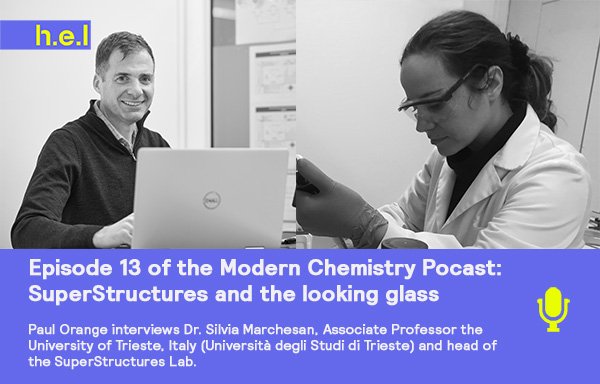Silvia Marchesan
SuperStructures and the
looking glass

Episode 13 of the Modern Chemistry podcast features Dr. Silvia Marchesan, Associate Professor at the University of Trieste, Italy (Università Degli Studi di
Our theme music is “Wholesome” by Kevin MacLeod
Music from Film Music
License: CC BY
Connect with me (Paul) on LinkedIn.
Trieste) and head of the SuperStructures Lab. Before her current position, Silvia has worked in the UK and Australia, using a range of biology and chemistry techniques. Her current research focus includes the self-assembling properties of superstructures and how to design the necessary building blocks that create those structures.
Terms used during interview
- Chirality – Chirality is a feature where an object can be distinguished from a mirror-image version of itself (for instance, left and right gloves or shoes). In chemistry, chirality is often due to the presence of an asymmetrical carbon atom. Chiral isomers are identified as either L-type or D-type, based on how polarized light is rotated when passing through a molecule.
- Superstructure – In the context of this discussion, “When the structures become way, way bigger than the building blocks, you can call the superstructures.” They represent massive polymers of the base construction molecules
- Nanomaterials / Nanoparticles – A term used to describe substances where the base unit is small – between 1 nm – 100 nm along one or more dimensions
- Amyloid beta-peptide (also known as Abeta, or Aβ) – Peptides between 36-43 amino acids long that form insoluble amyloid plaques in the brains of people who have Alzheimer’s disease. Although the specific role of Amyloid plaques in Alzheimer’s disease is not fully understood, it is widely accepted that they are responsible for the pathology of the disease.
- Peptide – A short chain of 2-50 amino acids linked by a peptide bond. A dipeptide has two amino acids in the chain; a tripeptide has three amino acids, and so on.
- Hydrophobic pockets – When folded into a functional configuration, the amino acids of a protein can be brought into physical proximity. When the majority of amino acids surrounding an ‘opening’ in the protein’s surface are hydrophobic, it creates a region that is unattractive to hydrophilic molecules. As the majority of biological systems are water-based, this hydrophobic region stimulates other hydrophobic regions of suitable molecules to bind. This then typically leads to downstream activation or effect
- Catalytic triads – a set of three coordinated amino acids that can be found in the active site of some enzymes. Catalytic triads are most commonly found in hydrolase and transferase enzymes.
- Antimicrobial resistance – This is an evolutionary process where bacteria become immune to the effects of antimicrobial agents (such as antibiotics). Typically this is caused by exposure are designed to kill bacteria. To do this, the bacteria need to be exposed to the agents at sub-lethal levels. As antimicrobial agents accumulate in the environment, it is believed that this provides an opportunity for bacteria to be exposed at sub-lethal levels, which accelerates the rate at which the bacteria develops resistance to the antimicrobial.
We discussed the drawing of Alice going through the looking glass during our discussion, you can see it here.
Silvia also mentions an article in the journal ACS Nano, you can find that here.
Silvia is contactable on social media, you can find her on LinkedIn and Twitter. You can also find out more on the group website.


